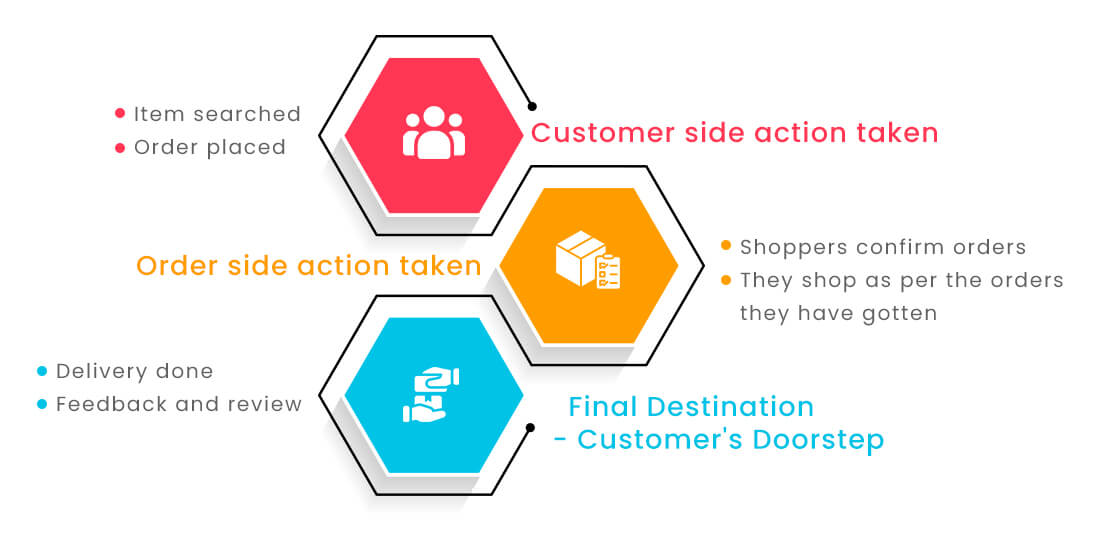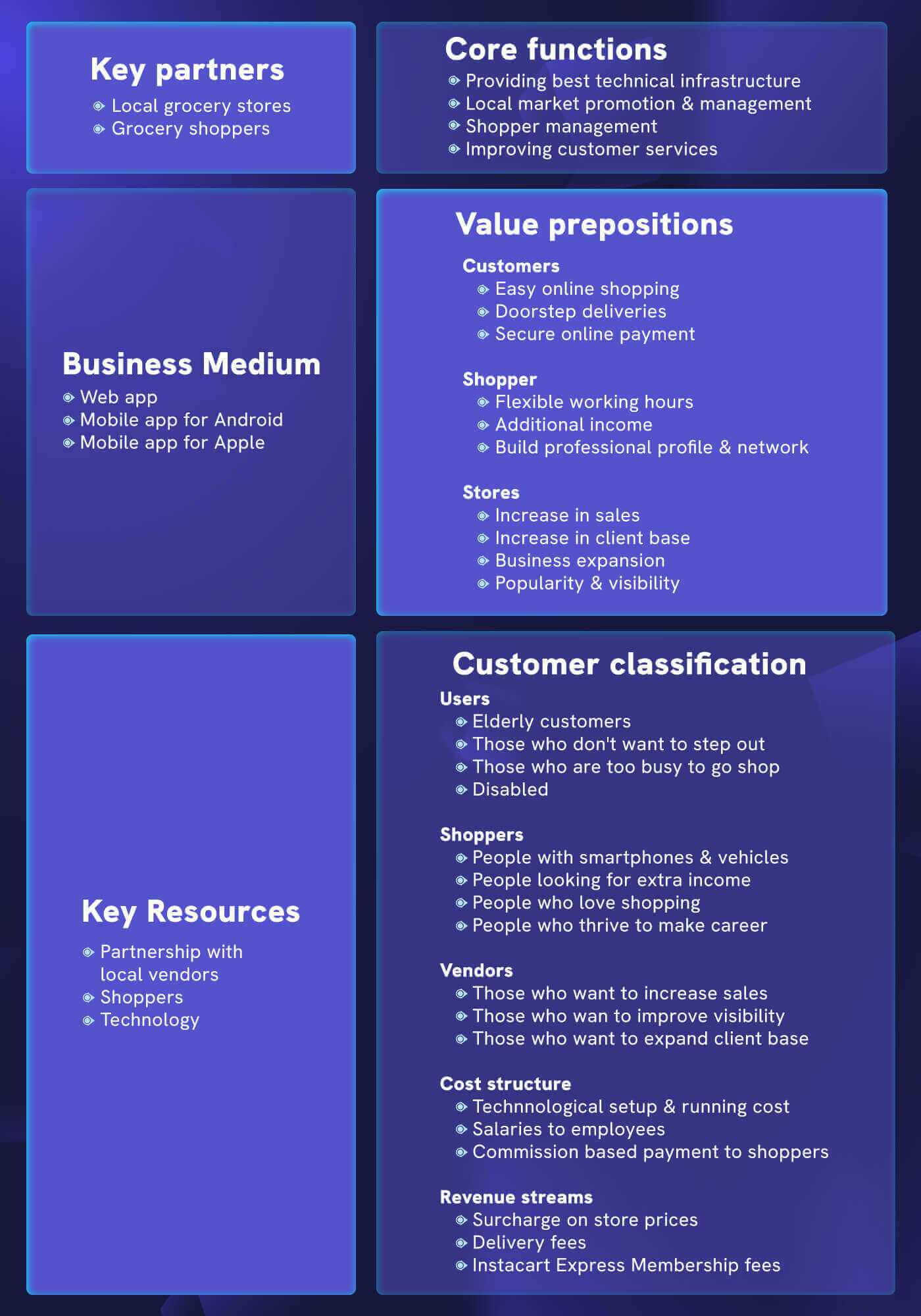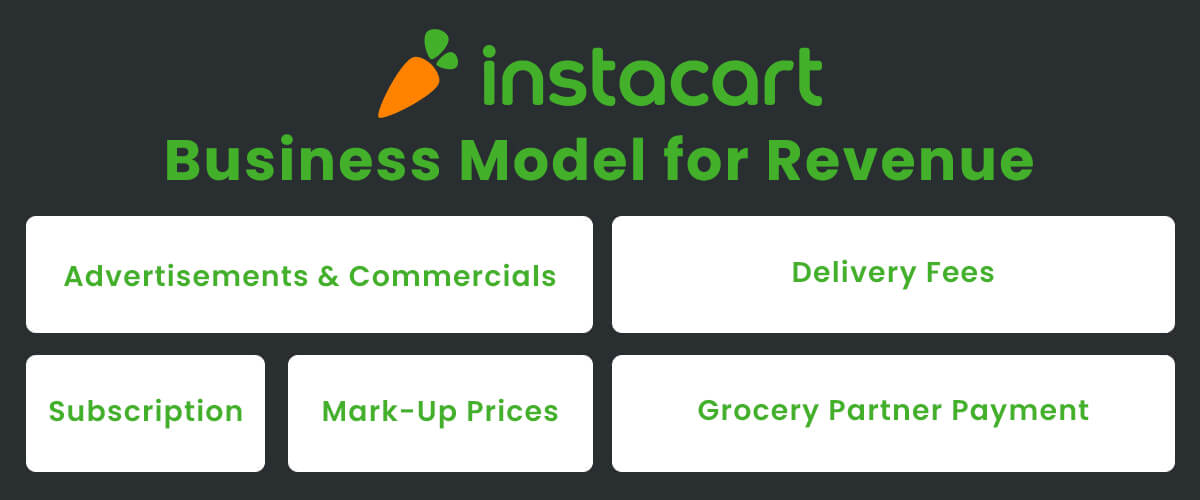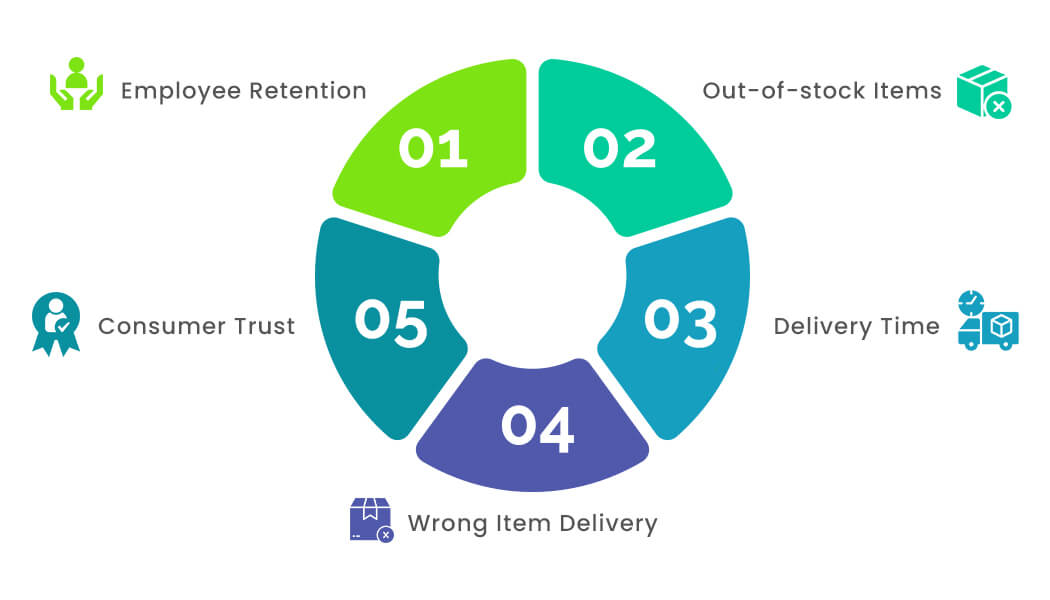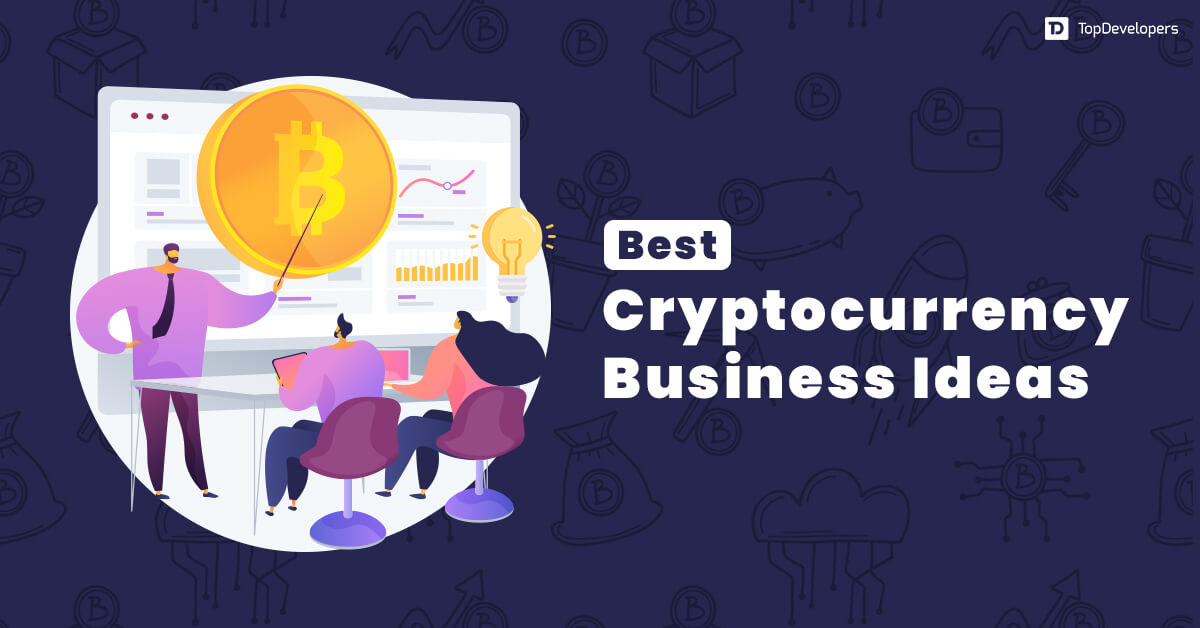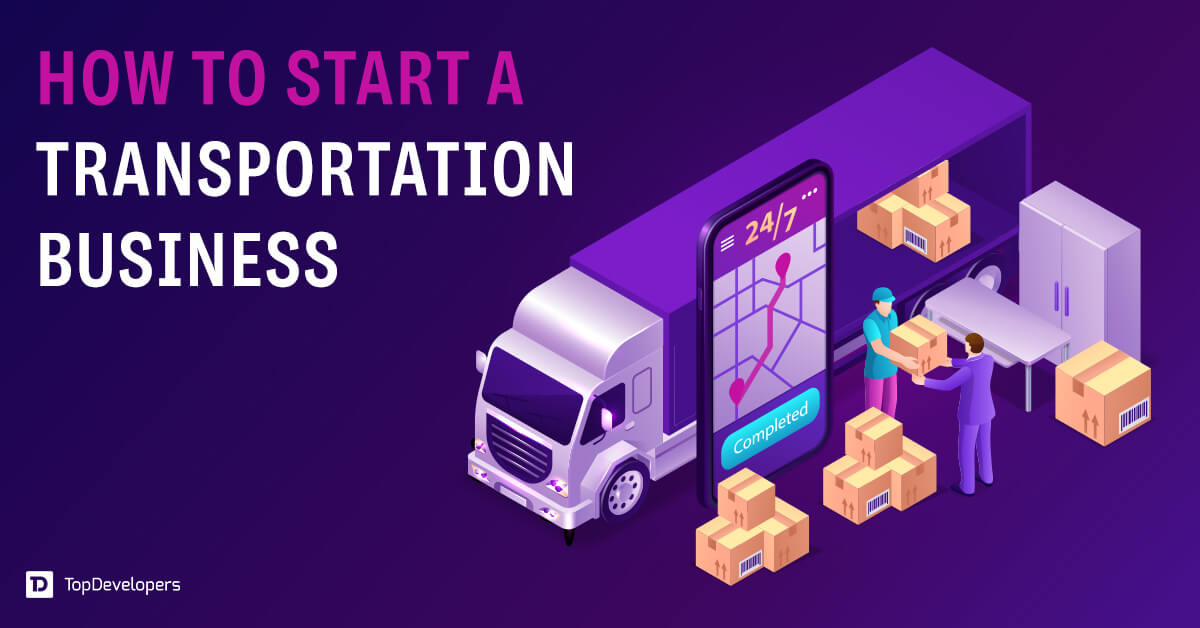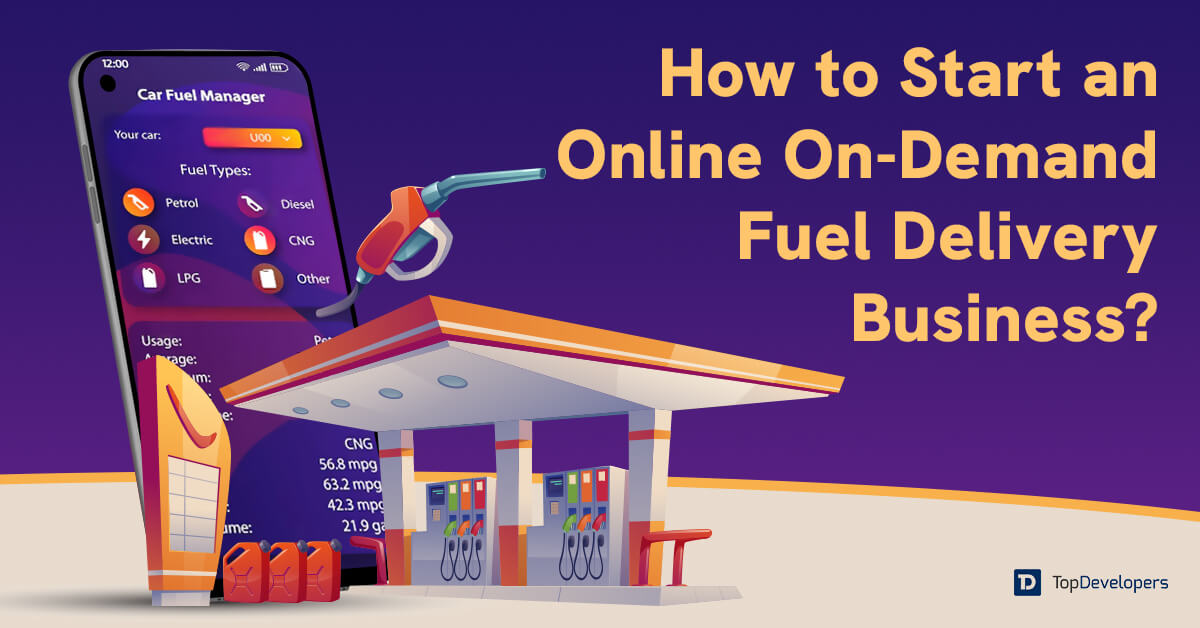
While other businesses showed feeble pulses during the unprecedented covid pandemic, Instacart generated nearly half a billion dollars in 2020 with a whopping USD 300 million in sales. Statista further states that Instacart accounted for 1.4% of US digital retail media ad spending in 2020 and the share is likely to shoot even further (more than 2%) in the coming year. Like Instacart, other on-demand apps with diversified niches, including a 10-minute grocery delivery app, fuel delivery, and food delivery app, have also been minting money for enterprises.
So, now that you find the above-mentioned stats and figures impressive enough, you wonder what is Instacart and how the Instacart business model works. Well, it is a leading online grocery delivery company with premium features that not only entice its users but also retain them to turn them into loyal customers. So, if you are thinking to start a grocery delivery business, this is the piece of information you would never regret having.
Simply put, Instacart is an online grocery delivery platform that provides faster doorstep deliveries of several items including groceries in most cities in the USA.
Table of Contents
- Instacart Statistics
- How does Instacart work?
- Instacart business model canvas
- Instacart value prepositions
- Instacart business model exposed
- Instacart’s referral program
- Instacart’s advertising strategies
- Instacart revenue: Challenges and their solutions
- Instacart Competitors’ analysis
- Want to start an Instacart-like business app?
- Overview of the Business Model of Instacart!
Instacart Statistics
Instacart is one of the most popular apps in the world with the growth proven since its inception and also showing promise in the future.
According to a report, Instacart, by 2024, is likely to hit sales in its home market touching US $40.5 billion which is around a 40% hike from its previous record.
Moreover, PrioriData report indicates that Instacart has about 13.7 billion daily active users, and nearly all in the US, around 92% use phones to shop with Instacart.
How does Instacart work?
The backbone of Instacart’s operations and business mechanism is its economy-based business model that sticks to the rudiments of hyperlocal on-demand grocery delivery trends to entice customers and local shoppers. No surprise that Instacart does not own even a single grocery store; it has just built a powerful platform where customers meet vendors.
Instacart mobile app is simple to navigate and easy to browse through. Here is a perfect example of a workflow of grocery business one should follow on their tool –
Instacart works exactly the way an on-demand grocery delivery app does. Nevertheless, the economy-based business model makes it unique. Here, the customers search for grocery items they want from a particular shop or whatever the app shows as a search result. The order is then placed where they mention the quantity.
On the order side, the shoppers (who are either independent contractors or part-time employees of Instacart) get and confirm the order. They then shop for the items from the list and head toward delivering them.
The final destination is the doorsteps of customers who have placed an order. The delivery is done securely and on time. Customers don’t need to step out of their homes to buy any item. Once the delivery is confirmed, the parties are suggested to provide ratings and reviews to help others. On the app store, consumers are also enabled to provide the overall experience they have with Instacart online grocery delivery app.
Instacart business model canvas
Instacart’s business revenue model includes several components and a focused approach. From key partners to core activities, and value prepositions to revenue streams – everything is strategically planned and implemented. Here, for your ease, we present a graphical presentation of the Instacart business model canvas –
Instacart value prepositions
Value proposition forms a foundation for any company, and for Instacart, their value proposition is at the forefront because of their business logic, and the company’s goal banks on it. Instacart grocery shopping flows through a particular pattern which makes Instacart business a foolproof strategically designed model.
Instacart’s technology platform supports its vision and mission and, therefore, Instacart makes money with ease. The business model of the company provides a win-win situation for all its stakeholders and users. The unique Instacart business model offers users what they want without any complexity in their business flows or shopping experience. Here is how it works –
For customers: Customers find it very easy to shop for groceries and other items. Those who are busy, elderly, and unwilling to go out for any reason find the on-demand grocery delivery app Instacart a boon.
For shoppers: Shoppers or Instacart employees are the ones who love shopping and roaming around. Out of their passion, they shop for the listed items they receive as online grocery shopping orders and deliver them to customers’ doorsteps. They earn per delivery and enjoy the extra income without disturbing their primary work or job. They can do this part-time or full-time at their convenience or choice.
Stores or vendors: For storekeepers or grocery shop owners, it is clearly the best source to sell their products or goods. They would see a marked increase in sales through the Instacart economy business model as now they are likely to get orders from various places and not restricted to geographical boundaries.
In addition to the above-mentioned users, Instacart’s business model for revenue also includes allowing local grocery manufacturers and/or retailers to advertise and sell their products on the app. In-app advertising is one such option they have. In addition, the company also enables gig workers to serve as full-time independent contractors or part-time job doers as personal shoppers.
Instacart business model exposed
The ultimate aim for most enterprises providing services and goods is to generate steady revenue for which they adapt innovative app-monetization models. Instacart, a leading online grocery delivery company, has a unique business revenue model that caters to everybody’s needs and provides a decent solution with the help of a neatly created Instacart mobile app for on-demand grocery delivery.
Here are the ways or multiple channels; this is how Instacart makes money –
Advertisements or commercials
Like any other on-demand grocery delivery application business, Instacart business also comes from adverts and commercials by vendors, shopkeepers, and even grocery stores of all kinds. The sellers and brands can design and put their advertisements at various places on the Instacart mobile app for online shopping.
Delivery fees
Instacart cost structure includes delivery fees and service fees. The grocery delivery business imposes delivery fees ranging from $3.99 to $9.99 depending on the goods and distance. Also, in some extreme weather conditions, the charges surge. These fees are distributed among stores and Instacart. Plus, there is also a service fee from 5% to 10% of purchases. Additional fees are also applied in this economy-based business model when the shipment parcel exceeds some weighing mark.
Subscriptions
The subscription fees are one of the revenue streams for the business model of Instacart. The company, for its Instacart Express services, makes on-demand grocery shopping more exciting and reliable. The subscription revenue model for Instacart enables consumers to have unlimited deliveries (or orders more than $35), cheaper service fees, and no surge prices for annual and monthly fees of $99 and $9.99 respectively.
Markups on prices
According to Instacart, it charges the same prices for grocery items and other goods as you find them in stores for most retailers such as Wholefoods. Nevertheless, there is a markup charge for other retailers (for example, Costco).
Grocery partner payment
Instacart makes money from imposing fees on registered grocery stores. In addition, Instacart also put charges (some percent) on grocers for the revenue that comes from sales. For instance, the company puts 3% of each order from an individual grocer. You may count it as a convenience or processing fee for handling the entire order and delivery cycle.
Instacart’s referral program
Instacart is known to be a user-friendly application. The company takes care of its customers through various tactics and initiatives, referral programs being a major one. The eCommerce platform brings highly engaging and lucrative referral programs to ensure the acquisition of newer customers while retaining the older ones.
Instacart targets the following factors in designing its referral programs –
- Build faith among customers/users
- Stay competitive in the tough market
- Enhance user engagement
- Improve user experience and satisfaction
- Stay different and unique among peers
- Enhance customer loyalty
The referral programs
Instacart thinks of long-term association and bonding with its customers and, therefore, prioritizes user-centric campaigns and promotions. Here are some of the known referral programs the company has deployed –
Rewards for referrals
The core referral program of Instacart is to refer to a friend or family member. Instacart recognizes the word-of-mouth publications and hence referrals were stunningly rewarded with perks while introducing Instacart to someone else. The primary incentive for the Instacart referral program was credits that ranged from US $10 to US $20. The figure may rise or fall depending on the phase of the campaign or promotions.
Rewards for referees
Just like referrals, referees also get benefits as programmed by Instacart. The company delights new users by offering them compelling incentives and rewards to those referred by friends and loved one. The first reward is a welcome discount or free delivery on their first purchase as an inaugural offer. This incentive generally ranges from 10%-20% on items or free delivery/shipping.
Win-Win Rewards
The dual-sided reward by Instacart is a unique referral program because both the referrer and the referee get benefits; hence, it is a win-win situation for both. This further enhanced and pushed word-of-mouth marketing because both parties would spread this good word from their side to their network. Strategically, this referral program would attract a bunch of people, and then again, the cycle continues.
Traditional rewards
You also witness Instacart having promotional campaigns and special offers as a traditional way to reward users. Special offers like bonus credits, discounts, festive special prices, and other offers add glory to customers’ delight.
Tiered rewards
It is not that Instacart offers rewards only to referrals and referees with discounts and free shipping. To encourage the customers to continue engagement and purchases, the company offers tiered rewards in which reaching a specific milestone will also bring happiness to customers. For instance, additional bonuses and credit amounts are provided when they reach a specific milestone – say a specific number of referrals.
Instacart’s advertising strategies
Instacart smartly reels in customers, retailers, and shoppers. Customers are the people who use the app to order groceries for delivery. The shoppers are independent contractors who pick and deliver goods through the Instacart shopper app. The advertising strategies of Instacart are a foolproof way to keep the business competitive:
Customers
The marketing strategies for customers include ease and convenience to get groceries because they are too busy to go and shop. This highlights varieties of products and Instacart ensures that they will get whatever they want in their ads. Discounts, coupons, offers, and other attractive campaigns are periodically rolled out.
Shoppers
The reliable workforce is the backbone of any business and Instacart knows this well. The advertising strategies of Instacart for shoppers revolve around flexibility to be a shopper. Setting your own hours and working around the schedule is the highlight to attract delivery partners as shoppers.
Retailers
Expanding reach and customer base is the primary goal for Instacart’s advertising strategies for retailers. The company shows a mammoth user base to attract retailers and a multifaceted approach to create a win-win-win situation for all bringing small, medium, and big retailers together.
Instacart revenue: Challenges and their solutions
The bigger the business, the tougher the challenges. For any company, a competitive market and volatile consumer demands would certainly bring major concerns. This company, too, faced several challenges but then Instacart value proposition and Instacart’s innovative business model saved it from impediments whatsoever.
Instacart’s business model remained intact because it could tactfully solve all the challenges it faced. If you want to start an on-demand grocery delivery business like Instacart, this guide will help you know the challenges beforehand only.
Here are a few challenges and solutions –
Employee retention
Shoppers and part-time employees at Instacart have other primary jobs and tasks to do. Hence, this business, for them, is secondary. It is difficult for an on-demand grocery shopping company to retain its employees.
To retain shoppers, Instacart’s business revenue model also has a good share of employees. Paying a tip to a shopper is one of the unique features the app has so that additional income is guaranteed.
Delivery time
Delivering groceries within two hours was a big challenge to Instacart because of the wide network of the app across the US cities. Consumers ordered their requirements with just a few taps on the grocery delivery application, but a herculean task would now begin to allotting the order to a shopper who is supposed to travel all the way to a particular grocery store, pick items, and finally deliver it to consumers’ doorsteps.
Instacart deployed their delivery men or shoppers right near the supermarket and grocers who would get the order and will shop for the items as soon as possible. This is how the company tackled the issue and started delivering the items within two hours.
Customer’s trust
Not true for just the on-demand grocery delivery app business, but customer trust is the backbone of any business’s success. Instacart, to avoid any such issue, has a powerful business strategy.
It observed negative reviews and feedback when the company started putting its own prices. Soon, Instacart’s business model changed and implemented the prices one would find in stores and supermarkets. In addition, Instacart’s’ revenue sharing methods noticed a tad change in its approach. Once the customer’s trust was won, Instacart gradually introduced marked-up prices but by then most users had become addicted to the app and they were ready to pay.
Wrong item delivery
Everyone is prone to make mistakes, and shoppers are no exception. If the shoppers picked the wrong items and delivered them to customers, there was a negative impact on Instacart’s on-demand grocery delivery business.
Instacart grocery business then had the facility of reaching out to customer care through chat or phone immediately. They would process a full refund in case the items delivered are not the ones that were ordered.
Out-of-stock items
Inventory management has been one of the biggest challenges, especially for grocery stores and supermarkets. Shoppers used to complain about the non-availability of certain items that they wanted to purchase. Instacart delivers orders as per the client’s requirements but then what if the items were not available and customers left feedback for the same?
Instacart allowed customers to add notes about the items that were running out of stock quite often. Hence, it would make a reference to other buyers before they placed an order. In addition, the vendors and grocers would also see the items that are in demand or simply go out of stock, and therefore they would take extra care of making it available for the next purchase.
Instacart Competitors’ analysis
Instacart is now considered one of the most popular eCommerce platforms where millions of people shop every day and the number is remarkably growing. Experts in eCommerce now consider Instacart as a potential big player in the world of online shopping along with Amazon and Walmart. The other major grocery delivery stores are the competitors of Instacart.
Here is a quick comparison analysis of Instacart and its competitors for your acknowledgment.
| Feature | Instacart | Amazon Fresh | Shipt | Walmart Grocery |
|---|---|---|---|---|
| Business Model | Marketplace – Partners with retailers for delivery | Owned by Amazon – Integrates with Prime membership | Subsidiary of Target – Integrates with Target membership | Owned by Walmart – Integrates with Walmart+ membership |
| Pricing | Delivery fees vary based on order size, speed, and membership (Instacart Express) | Free delivery with Prime membership, otherwise fees apply | Delivery fees vary based on order size and membership (Shipt membership) | Delivery fees vary based on order size and membership (Walmart+ membership) |
| Selection | Wide variety of stores depending on location | Limited to Amazon products | Focuses on Target inventory | Focuses on Walmart inventory |
| Market Strategy | Focuses on convenience and a wide selection of stores | Leverages existing Prime membership base | Offers integration with the Target loyalty program | Offers integration with Walmart loyalty program and competitive pricing |
Want to start an Instacart-like business app?
The time is now that you may think of venturing into an Instacart-like business as most on-demand delivery applications are doing quite well in the local and national markets. The first step to go about it is to pen down the business objectives and refine your search before you set out to find the best mobile app developers who can develop grocery delivery apps.
Once your outsourcing destination is fixed, you may fix a couple of meetings with your tech partner to mutually craft the best mobile app features specific to on-demand grocery app delivery.
Hire Remote Developers Team To Build Grocery Delivery App Like Instacart
Overview of the Business Model of Instacart!
The Instacart business model to generate revenue showcases uniqueness and, therefore, most on-demand grocery delivery businesses now follow the same. The company invests a hefty amount in its user experience research to know the current market trends and any change in consumer behavior.
That said, there are many reasons why Instacart’s revenue model is widely accepted as a standard business practice for steady income. You can simply adapt the same model to cover the app development cost you have invested, reach the break-even point quickly, and start generating profitable revenue.
Frequently Asked Questions about Instacart Business Model
What is Instacart’s business model?
Instacart’s business model is Instacart’s approach to generating revenues. There are several ways through which Instacart makes money. Such models are said to be an ideal way to assure steady revenues to any similar business i.e., an on-demand grocery delivery app business.
How to develop an Instacart-like app to generate good revenue?
You need to find the best mobile app development company that can build an app like Instacart with the same features and business logic. Build your own team and jump on to the lucrative business of on-demand grocery delivery business.
Can Instacart’s business model for revenue be implemented in my business of grocery delivery?
Of course, most of the on-demand grocery delivery businesses can implement the Instacart revenue model for their company. Nevertheless, you need to identify the areas or fields of difference where their business methods or objectives vary from yours. You may take the help of a business and technology consultant to have a foolproof strategy.
 Avantika Shergil
| May 31, 2024
Avantika Shergil
| May 31, 2024
Avantika Shergil is a technology enthusiast and thought leader with deep expertise in software development and web technologies. With over 8 years of experience analyzing and evaluating cutting-edge digital solutions, Avantika has a knack for demystifying complex tech trends. Her insights into modern programming frameworks, system architecture, and web innovation have empowered businesses to make informed decisions in the ever-evolving tech landscape. Avantika is passionate about bridging the gap between technology and business strategy, helping businesses build customized software and website, and understand about different tools to leverage effectively for their ventures. Explore her work for a unique perspective on the future of digital innovation.
